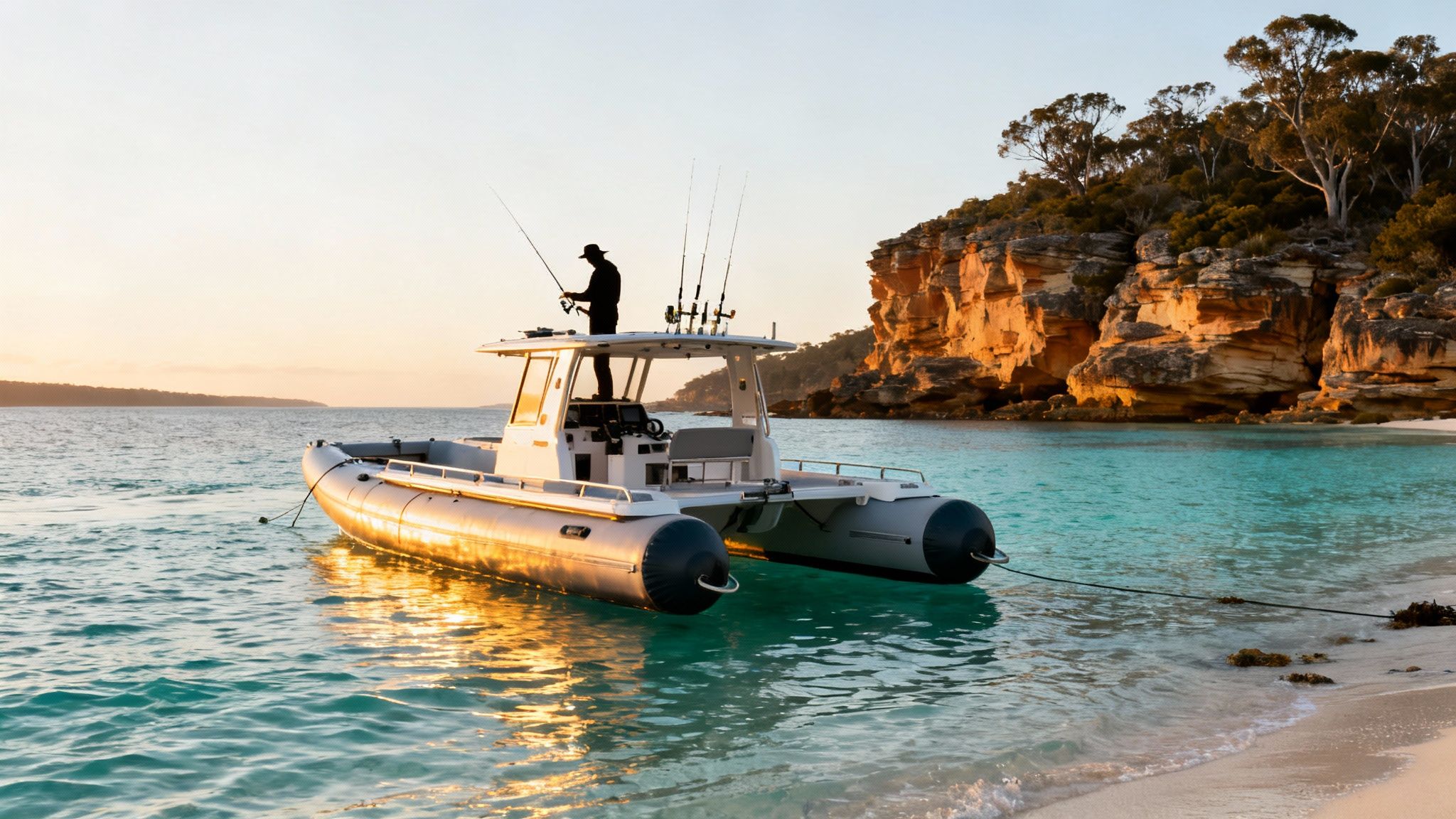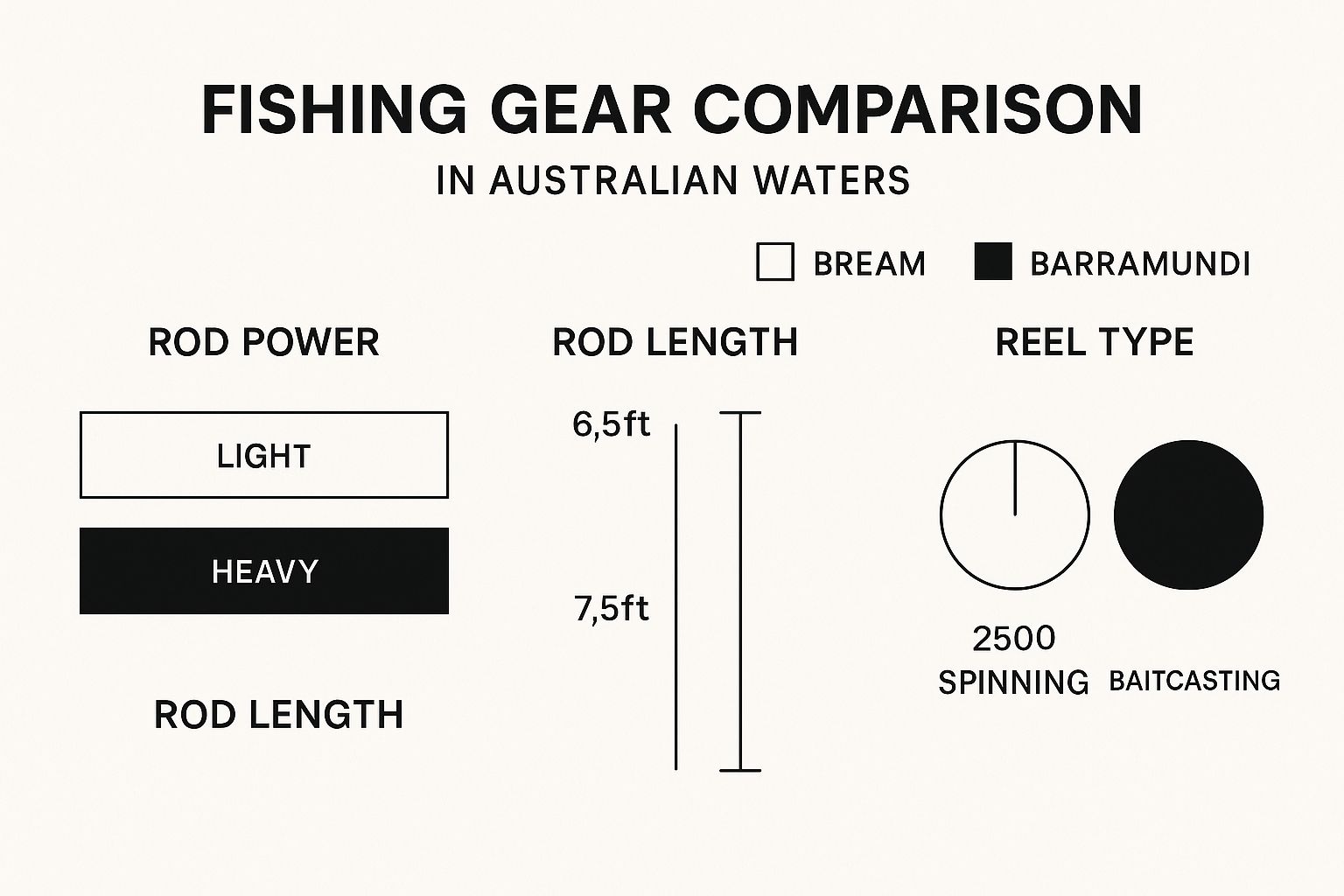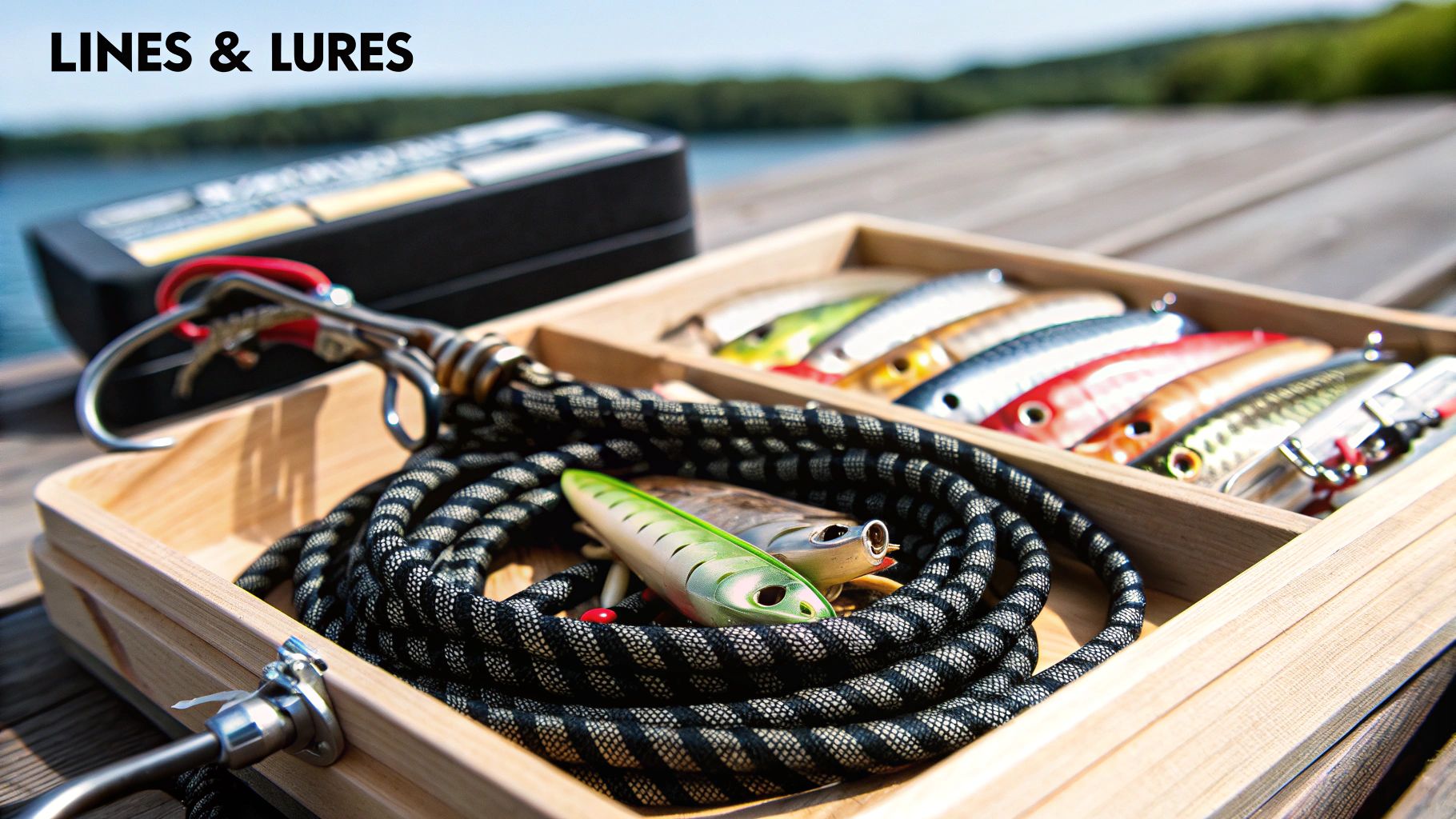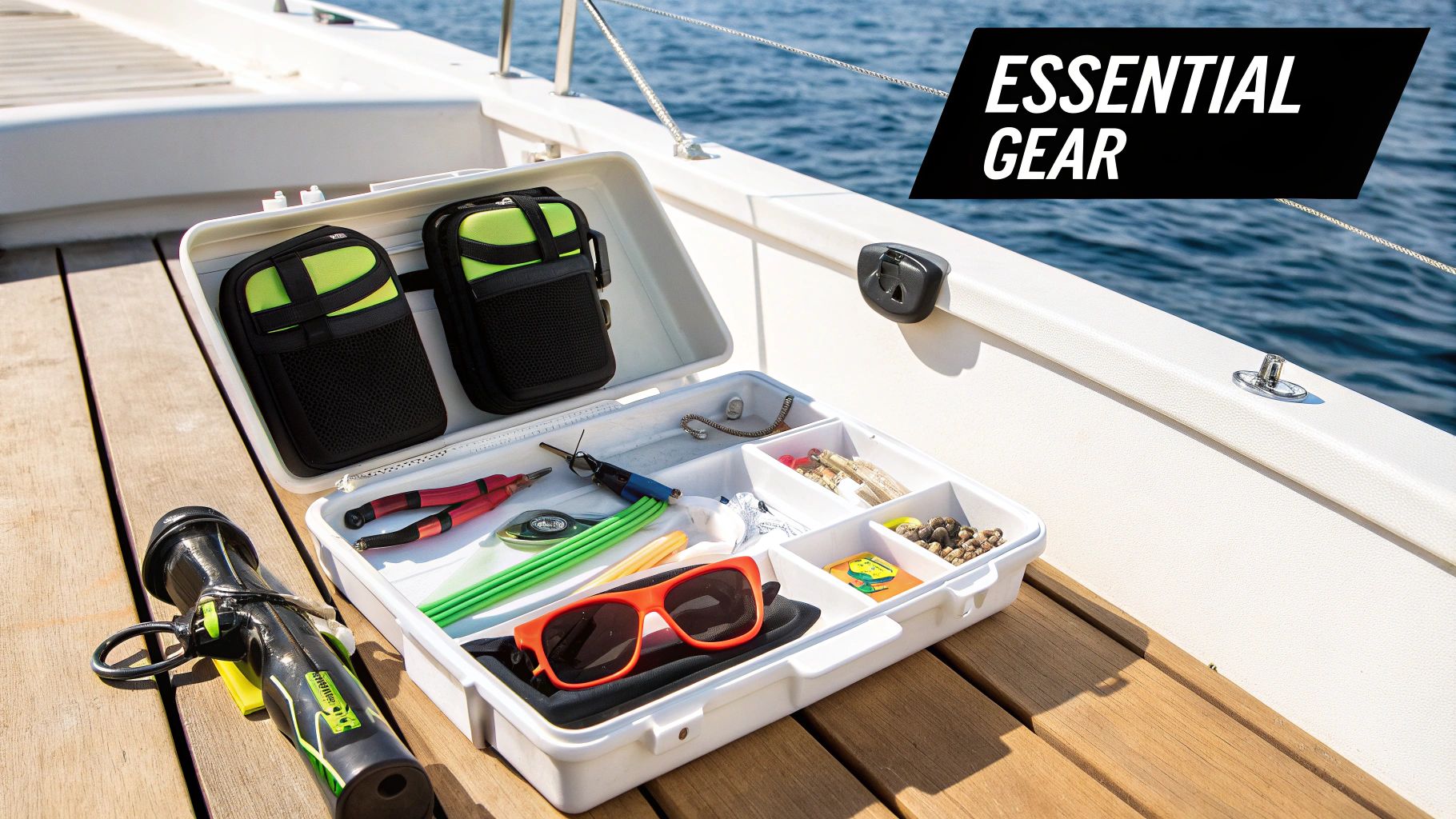
When it comes to fishing, your gear isn't just a collection of parts—it's a purpose-built system. Imagine trying to catch a feisty bream in a Sydney estuary with a broomstick of a rod designed for giant tuna; you wouldn't feel a thing. Conversely, chasing a metre-plus barramundi with flimsy bream gear is a recipe for disaster. The rod, reel, line, and lure all need to work in perfect harmony for the fish you're chasing.
Your success on the water hinges on this simple principle: match your equipment to your target and the conditions. Get it right, and you're in for an epic day. Get it wrong, and you're just casting and hoping.
Choosing the right fishing gear can feel overwhelming, but getting it right is the single most important step for a successful day on the water. This guide cuts through the noise to help you build the perfect fishing kit, whether you're launching an inflatable boat, casting from a kayak, or flicking lures from the shore.
We'll break down the core components—rods, reels, lines, and lures—and show you how they work together as a team. Think of it like a tradie's toolkit; you wouldn't use a tiny screwdriver to hammer in a big nail. The same logic applies directly to finding the best fishing gear.
The best fishing gear for chasing bream in a Sydney estuary is worlds apart from what you'd need for targeting a powerful barramundi in the Top End. One requires finesse and light tackle to feel the slightest nibble, while the other demands brute strength and control. Understanding this fundamental principle is the key to making smart choices.
This infographic breaks down the difference, comparing recommended gear for these two popular Australian species.

As you can see, the barramundi setup is all about power and leverage, while the bream gear is built for sensitivity and a delicate presentation.
This focus on specialised equipment reflects a bigger trend. Recreational fishing is booming in Australia, and it's driving massive growth in the local market. The Australian fishing equipment market was valued at around USD 38.9 million and is projected to skyrocket to USD 115.6 million by 2033. You can read more about this growth over at 6wresearch.com.
Choosing your gear correctly means more time fighting fish and less time fighting your equipment. It's the difference between landing that personal-best flathead and telling a story about the one that got away.
This guide will demystify the essentials, helping you make confident choices that lead to more fish and fewer frustrations. For anyone just starting out, our list of the 10 must-have fishing gear for new anglers is the perfect place to begin building your kit.
Your rod and reel are the heart and soul of your fishing setup. Getting this combination right is the difference between casting a tiny soft plastic with precision and flinging it wildly into the mangroves. Think of them as a team—if one part is out of sync, your casting, lure presentation, and ability to fight a fish will all suffer.
The rod does the heavy lifting: it casts your lure where you want it and absorbs the shock of a thrashing fish. Meanwhile, the reel manages your line and gives you the muscle to bring your catch in. Nailing this partnership is the first and most critical step in building a killer fishing kit.
Every rod is defined by two key characteristics: power and action. These terms might sound like jargon, but they’re simple concepts that tell you exactly how a rod will perform.
Power is all about the rod's backbone—its raw lifting strength. For example, a heavy-power rod is what you need for wrestling a big Murray cod out of thick snags. A light-power rod, on the other hand, is perfect for flicking 2-inch soft plastics for bream, where feeling the subtle bite is everything.
Action describes where the rod bends. It’s the personality of the rod.
Matching the power and action to your target species is the secret. For instance, a fast-action rod is ideal for feeling the subtle "tick" of a flathead inhaling your soft plastic.
Once you've got the rod sorted, it’s time to choose its partner. While there are plenty of specialist reels out there, two styles dominate the Aussie fishing scene: the spinning reel and the baitcaster.
The humble spinning reel is the undisputed workhorse of Australian fishing. It's incredibly user-friendly and brilliant for casting lightweight lures. A classic 2500-size spinning reel on a 7-foot, 2-4kg fast-action rod is a deadly combo for chasing flathead, bream, and bass. It's the perfect starting point.
Then you have the baitcaster reel. This is a high-performance machine that offers next-level casting accuracy and serious cranking power. Want to land a lure right beside a specific snag where a big Murray cod is hiding? A baitcaster is the tool for the job. While there's a steeper learning curve, mastering it lets you winch powerful fish like barramundi out of heavy cover with ease.
When you're fishing from an inflatable boat, keeping your outfits secure is crucial. A good holder, like our 360-swivel mount rod holder, not only protects your expensive gear from going for a swim but also keeps it ready for action when a school of tuna busts up nearby.
Choosing between a spinning reel and a baitcaster often comes down to your experience level and what you plan on fishing for. Here's a quick breakdown to help you decide.
| Feature | Spinning Reel | Baitcaster Reel |
|---|---|---|
| Best For | Beginners, light lures, general-purpose fishing. | Intermediate to advanced anglers, heavy lures, precision casting. |
| Ease of Use | Very easy to learn. Less chance of line tangles ("bird's nests"). | Requires practice to master thumb control and avoid backlash. |
| Casting Accuracy | Good, but less precise than a baitcaster, especially at distance. | Excellent. Allows for pinpoint accuracy when pitching and flipping into cover. |
| Power & Torque | Good for most applications, but can feel less direct under heavy load. | Superior cranking power and torque for fighting large, powerful fish. |
| Ideal Lures | Lightweight soft plastics, small hardbodies, unweighted baits. | Heavier spinnerbaits, large swimbaits, deep-diving crankbaits, and topwater lures. |
| Common Targets | Bream, flathead, whiting, trout, bass. | Murray cod, barramundi, mangrove jack, large flathead, kingfish. |
Ultimately, both have their place. Many experienced anglers carry both, switching to a baitcaster for spinnerbaits and a spinning reel for finesse plastics on the same day.
It's clear that Aussies are passionate about their gear. Fishing reels are a huge focus, making up 30.71% of all fishing equipment revenue in the country. With the entire market projected to grow at a rate of around 6.5% through 2030, our obsession with finding the perfect setup isn't slowing down anytime soon.

If your rod and reel are the engine, then your line, leader, and lure are the tyres—they’re your direct connection to the fish. Getting this combination right isn't just a minor detail; it's what determines whether you even feel the bite, let alone land the fish.
The wrong choice can make your lure look completely unnatural and spook a wary bream before you’ve even had a chance. So, let’s break it down.
Understanding the main types of fishing line is your first step. Getting this right is a huge piece of the puzzle when putting together the best fishing gear for your inflatable setup.
The three lines you’ll see dominating the shelves in any Aussie tackle shop are monofilament, braid, and fluorocarbon.
Monofilament ("Mono"): This is your classic, all-rounder line. It has a fair bit of stretch, which acts like a shock absorber during a fight. That stretch is an absolute lifesaver when a big flathead thrashes its head at the side of the boat, helping to stop the hooks from tearing out.
Braid: Made from tightly woven synthetic fibres, braid is ridiculously thin and has almost zero stretch. This gives you next-level sensitivity—you can feel every rock, weed, and subtle bite. Its skinny diameter also means you can cast further and pack more line onto your reel, a massive advantage.
Fluorocarbon: This line's superpower is being virtually invisible underwater, making it the ultimate leader material. It's also exceptionally tough and abrasion-resistant, perfect for resisting the sharp teeth of a tailor or the rough mouth of a barramundi.
Pro Tip: The most effective setup for most Aussie estuary and inshore fishing is to combine the strengths of two lines. Spool your reel with braid for sensitivity and casting distance, then tie on a metre of fluorocarbon leader for an invisible, tough-as-nails connection to your lure. This "best of both worlds" approach is a total game-changer.
With your line sorted, it’s time for the fun part: fooling the fish. Lures are all about imitating prey and triggering an aggressive feeding response. They generally fall into a few key categories.
Soft Plastics: Unbelievably versatile lures that mimic baitfish, prawns, and worms. A 3-inch paddle-tail soft plastic hopped along a sandy bottom is absolutely deadly on flathead. For snapper, a 7-inch jerk shad is irresistible.
Hard-Body Lures: These come in countless shapes, from shallow-running minnows that imitate a fleeing garfish to deep-diving crankbaits that get down to where the fish are holding. They’re brilliant for covering water quickly to find active fish.
Topwater Lures: There is nothing more exciting in fishing than watching a fish explode on a surface lure. A small popper blooped across the flats can draw brutal strikes from whiting, while a "walk-the-dog" stickbait is guaranteed to get a barramundi's attention.
For anyone starting out, a must-have lure pack for targeting flathead should include a mix of 3-4 inch paddle-tail and curl-tail soft plastics in natural colours. Chasing snapper? 5-7 inch soft plastics on heavier jig heads are your ticket to success.
You can find a brilliant selection to get you started by exploring the complete range of fishing gear available right here.

While your rod and reel get all the glory, it’s the accessories and safety gear that truly make or break a day on the water. They handle the small but critical jobs that keep things running smoothly, turning a good trip into a great one and keeping you safe out there.
The right accessories aren't just about convenience—they're fundamental to being a responsible angler and protecting your investment in the best fishing gear.
Some tools are simply non-negotiable. These items don't just help you land fish; they ensure you can handle them safely and efficiently once they’re on board. Equip your tackle bag with these essentials:
The popularity of quality gear reflects a much broader trend across the country. Australia’s fishing gear market was valued at about USD 18.23 million, with strong growth projected ahead. It’s all driven by our incredible coastline and a growing national passion for recreational fishing.
Even more important than your fishing tools is the gear that keeps you safe. Conditions on the water can change in a heartbeat, and being prepared isn't an option—it's a responsibility.
Your safety gear is the most important part of your kit. It's the equipment you hope you never need, but you'll be incredibly grateful to have if something goes wrong.
Make sure your boat is always kitted out with these items before you leave the shore:
Building out your kit with the right gear is key, especially when fishing from a smaller vessel like an inflatable. Our guide on essential inflatable boat accessories gives you a detailed checklist to make sure you have everything you need for a safe and successful trip.
Modern tech has completely changed the game for anglers. What used to be a guessing game of "there might be fish here" is now a precise science, and the two most powerful tools you can have are a fish finder and a GPS. This is a huge part of putting together the best fishing gear for your boat.
Think of a fish finder as your eyes underwater. It sends out sonar pings and listens for the echoes, painting a detailed picture of everything happening below. It’s not just about spotting fish—it's about finding the specific underwater structures that big predatory fish love to call home, like rocky drop-offs, sunken trees, and schools of baitfish.
The real magic happens once you learn to translate the on-screen display into actionable fishing intel. The most common technologies you'll come across are CHIRP, DownScan, and SideScan.
CHIRP Sonar: This is your classic "fish arch" view. It’s fantastic at separating individual fish from schools of bait, giving you a clear idea of what’s directly beneath your boat. It’s your go-to for confirming you’re right on top of the action.
DownScan Imaging: This tech gives you a much sharper, almost photo-like image of what's directly below. Instead of arches, you'll see the distinct shapes of tree branches and rocks, making it much easier to interpret what you’re looking at.
SideScan Imaging: This is the ultimate search tool. It scans out to both sides of your boat, letting you spot a log pile or a school of fish 50 metres away long before you ever drive over it. It's perfect for finding new, unpressured fishing spots.
Pairing sonar with an integrated GPS is what truly changes everything. When you find a promising-looking drop-off or mark a big school of fish, you can instantly save that exact location as a 'waypoint'.
A GPS waypoint is like dropping a digital pin on a map. It lets you return to that exact spot with pinpoint accuracy on your next trip, so you can build a library of proven hotspots and stop wasting time fishing in empty water.
This combination transforms how you fish. It allows you to build a personal library of proven spots, dramatically increasing your chances of success every single time you hit the water. Investing in a reliable fish finder/GPS combo is one of the smartest upgrades any boat angler can make.
Dropping your hard-earned cash on the best fishing gear is one thing, but keeping that gear in top-notch condition is how you protect your investment. Proper, consistent maintenance is the secret to making sure your equipment doesn't let you down right when you’ve hooked the fish of a lifetime.
A simple post-trip routine is all it takes to dodge the most common gear failures, especially if you’re fishing in saltwater where corrosion is always lurking.
For any saltwater angler, the single most important habit you can build is to thoroughly rinse your rod and reel with fresh water after every single trip. Salt is unbelievably corrosive and will seize up bearings and eat away at metal parts if left unchecked.
Once everything is rinsed and dried, a quick inspection can save you a world of hurt down the track.
Think of gear maintenance as part of the fishing trip itself—the final, crucial step. A five-minute rinse and inspection today prevents a snapped line, a seized reel, and a lost fish tomorrow. It’s the cheapest insurance policy you can have.
These simple habits don't just apply to your tackle; it's about looking after all your equipment. For those of us fishing from an inflatable, our guide to inflatable boat maintenance made simple provides a complete checklist to protect your entire setup. Take care of your gear, and it’ll be ready to go every time you are.
Choosing the right fishing gear can feel like a minefield, but it doesn't have to be. Let's tackle a few of the most common questions anglers ask to get you on the right track.
You can't go wrong with a versatile setup. Get a 7-foot graphite spinning rod rated for 2-4kg and match it with a 2500-size spinning reel. This combination is perfect for chasing Aussie favourites like bream, flathead, and whiting in estuaries and rivers. Spool it with 10lb braided line and finish it with an 8-12lb fluorocarbon leader for a presentation that fools even the wariest fish.
You don’t need to break the bank. For a reliable beginner combo from a trusted brand like Shimano, Daiwa, or Penn, expect to spend between $150 and $250. This price point is the sweet spot for a huge jump in performance and durability, ensuring your gear will last season after season instead of needing replacement after a few trips.
While you can absolutely catch fish without one, a fish finder gives you a massive advantage. It's like having x-ray vision into the water, showing you exactly where the drop-offs, weed beds, and hidden snags are—the exact places fish love to hide.
A fish finder stops you from fishing blind and turns your outing into a calculated hunt. Instead of guessing, you’re targeting fish where they live, which means more time with a bent rod and less time wondering where they are.
Even a basic unit will dramatically improve your catch rate and make your time on the water far more productive.
Ready to find the perfect inflatable boat to pair with your new gear? At Easy Inflatables, we specialise in creating high-performance, portable boat packages for Aussie anglers. Explore our range and get on the water with confidence.
Article created using Outrank
Experience the ultimate freedom on the water with our top-quality inflatable boats and accessories. Easy Inflatables is your trusted partner, providing everything you need for a safe and unforgettable adventure.
At Easy Inflatables, we believe in empowering adventurers with high-quality inflatable solutions. Our commitment to durability and performance ensures that every product enhances your outdoor experiences.